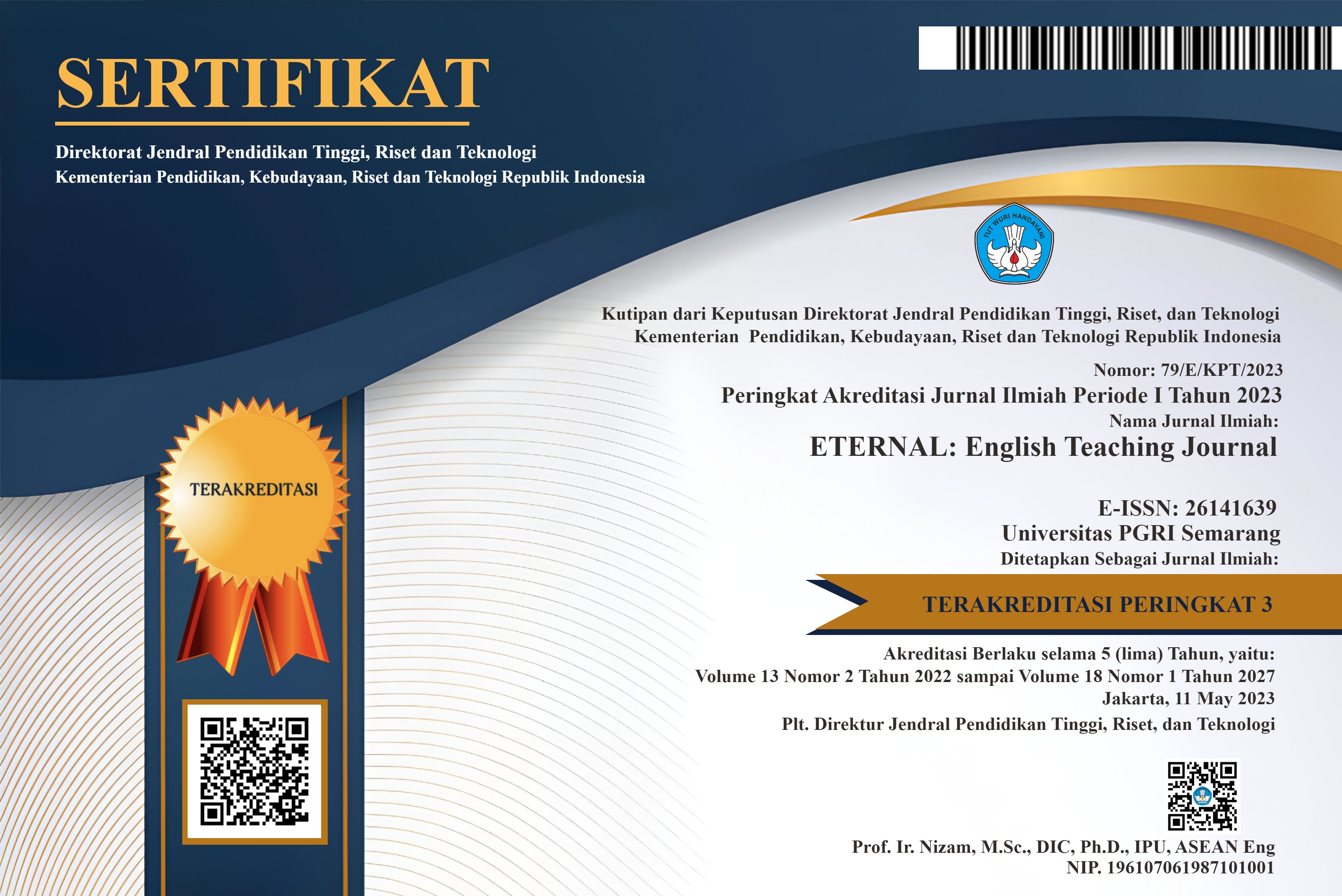Authentic Assessment in Examining EFL Students’ Writing
DOI:
https://doi.org/10.26877/eternal.v15i1.349Keywords:
Authentic Assessment,, EFL,, WritingAbstract
This writing intended to explore authentic assessment in teaching EFL writing, focusing on how the authentic assessment is presented in writing, the problem of the implementation, as well as the effectiveness. This is a literature review writing that examines previous articles. According to previous studies, some teachers have used authentic assessment to evaluate their students’ writing skills, but they have faced some challenges such as lack of time and resources to implement all kinds of authentic assessment. Authentic assessment is a powerful way to measure student writing because it allows students to write about realistic situations that suit their needs, and it can also enhance their writing abilities, motivation, enthusiasm, and desire to write
References
Arianda, W., Komariah, E., & Burhansyah. (2021). The effectiveness of authentic assessment in assessing students’ writing skills. Research in English and Education (READ), 6 (2), 62-71.
Ashford-Rowe, K., Herrington, J., & Brown, C. (2014). Establishing the critical elements that determine authentic assessment. Assessment & Evaluation in Higher Education. 39(2), 205-222.
Bean, J. C. (2011). Engaging ideas: The professor's guide to integrating writing, critical thinking, and active learning in the classroom. John Wiley & Sons.
Black, P., & Wiliam, D. (1998). Assessment and classroom learning. Assessment in Education: Principles, Policy & Practice, 5(1), 7-73.
Boud, D. (1995). Assessment and learning: contradictory or complementary? Kogan Page.
Brown, H, D., and Abeywickrama, P. (2010). Language Assessment Principles and Classroom Practices (Second Edition). Pearson Education, Inc
Cahyono. B, Y, & Rahayu, T. (2020), EFL students’ motivation in writing, writing proficiency, and gender. TEFLIN Journal - A publication on the teaching and learning of English. http://dx.doi.org/10.15639/teflinjournal.v31i2/162-180
Frey, B. B. (2013). Modern classroom assessment. SAGE Publications.
Goodson, L., & Rohani, F. (1998). Higher Order Thinking Skills• Definition• Teaching Strategies• Assessment. Thinking, 18, 458.
Garza, de la. D. E. M. A. (2011). A guidebook for assessing learning. Naucalpan, Empresas Ruz
Gulikers, J., Bastiaens, Th., & Kirschner, P. (2004). A five-dimensional framework for authentic assessment. Educational Technology Research and Development, 52(3), 67e85.
Graham and Perin (2007), Effective Strategies to Improve Writing of Adolescents in Middle and High Schools. Alliance for Excellent Education.
Hanifah, N. (2019). Teachers’ perception of authentic assessment for assessing students’ writing tasks in the rural area. RETAIN. 7 (2), (38-47).
Johanes, R & Alsaqaf, A, (2022), The Effect of Analytic Text-Based Writing Strategies on ESL Argumentative Writing Among Malaysian Form-Six Students in Sabah, Malaysia: English Language Teaching Research and Practices. A Proposal. Proceedings International Conference on Teaching and Education (ICoTE) Vol. 3. DOI: http://dx.doi.org/10.26418/icote.v3i1.55855
Khamasah, F.R, Atibrata, T.G (2023) The application of authentic assessment methods for students' writing skill (case study at tenth grade of ma assalafiyyah mlangi. JEEYAL (The Journal of English Teaching for Young and Adult Learners). Vol. 02
Maharani, A.A.P, (2019) An argumentative essay scale: its assessment criteria to employ. International Seminar on Language, Education, and Culture, KnE Social Sciences, pp. 299–308.
McCarty, G. (2013). Authentic assessment-key to Learning. University of Wollongong, Faculty of Business Papers
Messick, S. (1994). The interplay of evidence and consequences in the validation of performance assessments. Educational Researcher, 23(2), 13-23
Moria, E., Refnaldi, & Zaim, M. (2017) Using authentic assessment to better facilitate teaching and learning: the case for students’ writing assessment. Sixth International Conference on Languages and Arts: Advances in Social Science, Education, and Humanities Research (ASSEHR), 148.
Muthohharoh, S.R., Bharati, D.A.L., & Rozi, F. (2020) The implementation of authentic assessment to assess students’ higher order thinking skills in writing at man 2 tulungagung. English Education Journal 10 (3), 374-386.
Natalia, D. E., Asib, A., & Kristina, D. (2018) The application of authentic assessment for students’ writing skill. Journal of Education and Human Development, 7, (2), pp. 49-53.
Nguyen, T. T. K., & Phan, H.M. (2020). Authentic assessment: a real-life approach to writing skill development. Proceedings of the Eighth International Conference on Languages and Arts: International Journal of Applied Research in Social Sciences, 2 (1), pp. 20-30.
O’Malley, J.M. and Pierce, L.V. (1996). Authentic Assessment for English Language Learners: Practical Approaches for Teacher. Addison-Wesley Publishing Company Research Project Assignment
Pamela, K., Refnaldi., & Zaim, M. (2019). Teachers’ needs for authentic assessment to assess writing skills at grade x of senior high schools in Tanah Datar. Advances in Social Science, Education, and Humanities Research, 463.
Rowley, J., & Slack, F. (2004). Conducting a literature review. Management Research News, 27(6), 31-39.
Ryan, R. M., & Deci, E. L. (2000). Intrinsic and extrinsic motivations: Classic definition and new directions. Contemporary Educational Psychology, 25(1), 54-67.
Sarwanti, S. (2015) Authentic assessment in writing. Transformatika, 11, (2). ISSN 0854- 8412.
Siahaan, J. et al, (2021) The effect of reflective journal authentic assessment on students’ writing competence and motivation. Educational Studies: Conference Series, Vol. 1 No. 1, 2021
Xu, J. (2017), Assessment for Learning in English Language Classrooms in China: Contexts, Problems, and Solutions. Innovation in Language Learning and Teaching. DOI:10.1057/978-1-137-60092-9_2
Yashima, T., Noels, K. A., Shizuka, T., Takeuchi, O., Yamane, S., & Yoshizawa, K. (2009). The interplay of classroom anxiety, intrinsic motivation and gender in the Japanese EFL context. Journal of Foreign Language Education and Research, 17, 41-64.







